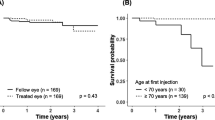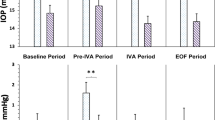Abstract
Background
The use of intravitreal anti-VEGF agents in general, and of bevacizumab (Avastin) in particular, has become the common first-line treatment of neovascular age-related macular degeneration (AMD). Several reports addressed the possible elevation of intraocular pressure (IOP) following intravitreal injection of anti-VEGF. The aim of this study was to determine the prevalence of sustained IOP elevation following intravitreal bevacizumab injections for neovascular AMD and identify possible risk factors for the development of increased IOP.
Methods
This retrospective cohort study included 174 consecutive patients (201 eyes) receiving intravitreal bevacizumab (1.25 mg/0.05 ml) as treatment for neovascular AMD. The records of the study patients were reviewed for age, gender, history of glaucoma, phakic status, IOP levels, length of follow-up, total number of injections, intervals between injections, and IOP management in eyes that exhibited IOP elevation. Sustained IOP elevation was defined as IOP ≥22 mmHg and a change from baseline of ≥6 mmHg recorded on at least two consecutive visits and lasting ≥30 days. Risk factors for an IOP increase were identified from the association between the studied variables and IOP elevations.
Results
Sustained IOP elevation was found in 22 of 201 eyes (11%). The increased IOP was controlled with topical medications in all eyes. Among the variables studied, only male gender [OR = 3.1, 95% CI (1.1, 8.5) p = 0.029] and length of interval between injections <8 weeks [OR = 3.0, 95%CI (1.1, 7.9), p = 0.028] emerged as risk factors for IOP elevation in a multivariable model. The prevalence of IOP elevation was significantly higher when the interval between injections was <8 weeks than ≥8 weeks (17.6 and 6%, respectively, p = 0.009). Pre-existing glaucoma was not associated with IOP elevation (p = 0.9).
Conclusions
Sustained IOP elevations can occur in normotensive eyes undergoing intravitreal bevacizumab treatment for neovascular AMD. This phenomenon was related to shorter intervals between injections, with 8 weeks being taken as the cut-off point. AMD eyes that receive intravitreal bevacizumab injections need to be monitored for IOP changes, especially those in which the intervals between injections are <8 weeks.

Similar content being viewed by others
References
CATT Research Group, Martin DF, Maguire MG, Ying GS, Grunwald JE, Fine SL, Jaffe GJ (2011) Ranibizumab and bevacizumab for neovascular age-related macular degeneration. N Engl J Med 364:1897–1908
Kahook MY, Kimura AE, Wong LJ (2009) Sustained elevation in intraocular pressure associated with intravitreal bevacizumab injections. Ophthalmic Surg Lasers Imaging 40:293–295
Sniegowski M, Mandava N, Kahook MY (2010) Sustained intraocular pressure elevation after intravitreal injection of bevacizumab and ranibizumab associated with trabeculitis. Open Ophthalmol J 4:28–29
Bakri SJ, McCannel CA, Edwards AO, Moshfeghi DM (2008) Persistent ocular hypertension following intravitreal ranibizumab. Graefes Arch Clin Exp Ophthalmol 246:955–958
Adelman RA, Zheng Q, Mayer HR (2010) Persistent ocular hypertension following intravitreal bevacizumab and ranibizumab injections. J Ocul Pharmacol Ther 26:105–110
Tseng JJ, Vance SK, Della Torre KE, Mendonca LS, Cooney MJ, Klancnik JM, Sorenson JA, Freund KB (2011) Sustained increased intraocular pressure related to intravitreal antivascular endothelial growth factor therapy for neovascular age-related macular degeneration. J Glaucoma 2011. doi:10.1097/IJG.0b013e31820d7d19
Good TJ, Kimura AE, Mandava N, Kahook MY (2011) Sustained elevation of intraocular pressure after intravitreal injections of anti-VEGF agents. Br J Ophthalmol 95:1111–1114
Hohn F, Mirshahi A (2010) Impact of injection techniques on intraocular pressure (IOP) increase after intravitreal ranibizumab application. Graefes Arch Clin Exp Ophthalmol 248(10):1371–1375
Leske MC, Connell AM, Schachat AP, Hyman L, Barbados Eye Study Group (1994) The Barbados Eye Study: prevalence of open-angle glaucoma. Arch Ophthalmol 112:821–829
Leibowitz HM, Krueger DE, Maunder LR, Milton RC, Kini MM, Kahn HA, Nickerson RJ, Pool J, Colton TL, Ganley JP, Loewenstein JI, Dawber TR (1980) The Framingham Eye Study monograph: an ophthalmological and epidemiological study of cataract, glaucoma, diabetic retinopathy, macular degeneration, and visual acuity in a general population of 2631 adults, 1973–1975. Surv Ophthalmol 24(suppl):335–610
AGIS Investigators (2002) The Advanced Glaucoma Intervention Study (AGIS): 12. Baseline risk factors for sustained loss of visual field and visual acuity in patients with advanced glaucoma. Am J Ophthalmol 134:499–512
Bakri SJ, Larson TA, Edwards AO (2008) Intraocular inflammation following intravitreal injection of bevacizumab. Graefes Arch Clin Exp Ophthalmol 246:779–781
Liu L, Ammar DA, Ross LA, Mandava N, Kahook MY, Carpenter JF (2011) Silicone oil microdroplets and protein aggregates in repackaged bevacizumab and ranibizumab: effects of long-term storage and product mishandling. Investig Ophthalmol Vis Sci 52:1023–1034
Kahook MY, Liu L, Ruzycki P, Mandava N, Carpenter JF, Petrash JM, Ammar DA (2010) High-molecular-weight aggregates in repackaged bevacizumab. Retina 30:887–892
Financial support
None.
Author information
Authors and Affiliations
Corresponding author
Additional information
The authors have full control of all primary data and they agree to allow Graefes Archive for Clinical and Experimental Ophthalmology to review our data upon request.
Rights and permissions
About this article
Cite this article
Mathalone, N., Arodi-Golan, A., Sar, S. et al. Sustained elevation of intraocular pressure after intravitreal injections of bevacizumab in eyes with neovascular age-related macular degeneration. Graefes Arch Clin Exp Ophthalmol 250, 1435–1440 (2012). https://doi.org/10.1007/s00417-012-1981-0
Received:
Revised:
Accepted:
Published:
Issue Date:
DOI: https://doi.org/10.1007/s00417-012-1981-0




